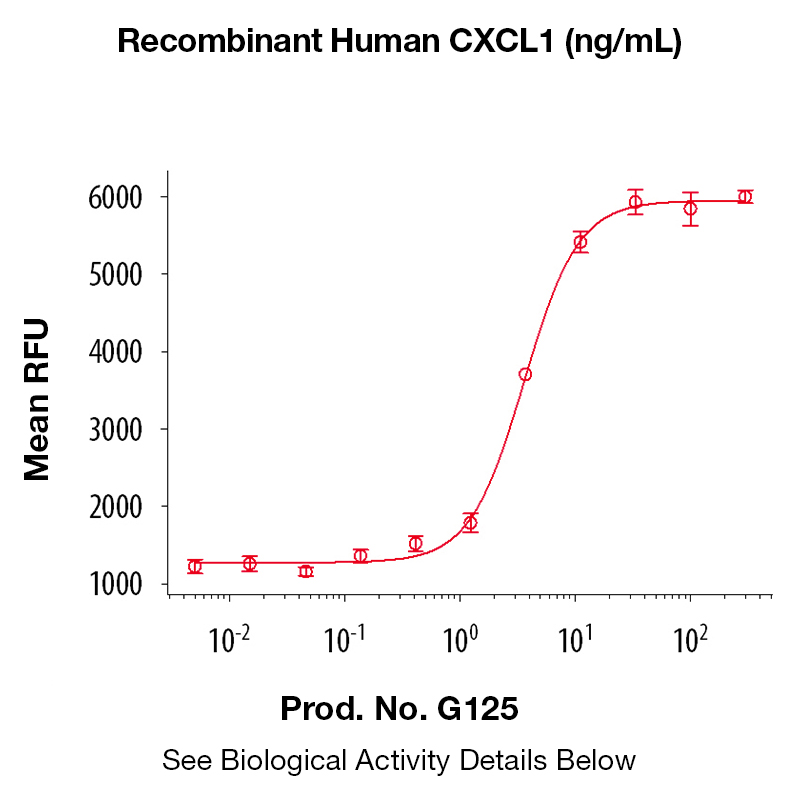Recombinant Human CXCL1
Data
- -
- -
BackgroundChemokine (C-X-C motif) ligand 1 (CXCL1) is a small cytokine with mitogenic properties belonging to the CXC chemokine family that was previously called GRO1 oncogene, GROα, KC, Neutrophil-activating protein 3 (NAP-3) and melanoma growth stimulating activity, alpha (MSGA-α).1 CXCL1 is expressed by macrophages, neutrophils and epithelial cells.2 CXCL1 plays a role in spinal cord development by inhibiting the migration of oligodendrocyte precursors and is involved in the processes of angiogenesis, inflammation, wound healing.3,4 Protein DetailsPurity >97% by SDS-PAGE and analyzed by silver stain. Endotoxin Level <0.01EU/µg as determined by the LAL method Biological Activity The biological activity of Human GRO/MGSA was determined by its ability to induce myeloperoxidase release from cytochalasin treated neutrophils (Schröder, J. et al., 1987, J. Immunol. 139:3474), or chemotaxis of mouse BaF/3 cells transfected with hCXCR2. The expected ED<sub>50</sub> for these effects are typically 0.15 - 0.3 μg/ml or 1 - 4 ng/ml, respectively. Protein Accession No. P09341 Amino Acid Sequence asvate lrcqclqtlq gihpkniqsv nvkspgphca qteviatlkn grkaclnpas pivkkiiekm lnsdksn N-terminal Sequence Analysis Ala35 State of Matter Lyophilized Predicted Molecular Mass The predicted molecular weight of Recombinant Human CXCL1 is Mr 7.9 kDa. Predicted Molecular Mass 7.9 Formulation This recombinant protein was lyophilized from a 0.2 μm filtered solution in 35% acetonitrile (CH3CN) and 0.1% trifluoroacetic acid (TFA). Storage and Stability This lyophilized protein is stable for six to twelve months when stored desiccated at -20°C to -70°C. After aseptic reconstitution, this protein may be stored at 2°C to 8°C for one month or at -20°C to -70°C in a manual defrost freezer. Avoid Repeated Freeze Thaw Cycles. See Product Insert for exact lot specific storage instructions. Country of Origin USA Shipping Next Day Ambient NCBI Gene Bank References & Citations1. Sager, R. et al. (1990) Proc. Natl. Acad. Sci. U.S.A. 87: 7732 2. Grotendorst, GR. et al. (1990) Mol. Cell. Biol. 10: 5596 3. Miller, RH. et al. (2002) Cell 110: 373 4. Richmond, A. et al. (2000) J. Invest. Dermatol. 115: 234 Certificate of AnalysisIMPORTANT Use lot specific datasheet for all technical information pertaining to this recombinant protein. |
Related Products
- -
- -
Prod No. | Description |
|---|---|
C1393 | |
C1394 | |
C1420 | |
K135 | |
I-202 | |
G118 | |
G121 | |
G126 | |
G125 | |
K125 | |
K114 | |
G144 | |
G718 | |
G145 | |
K124 | |
C1608 |
 Products are for research use only. Not for use in diagnostic or therapeutic procedures.
Products are for research use only. Not for use in diagnostic or therapeutic procedures.



